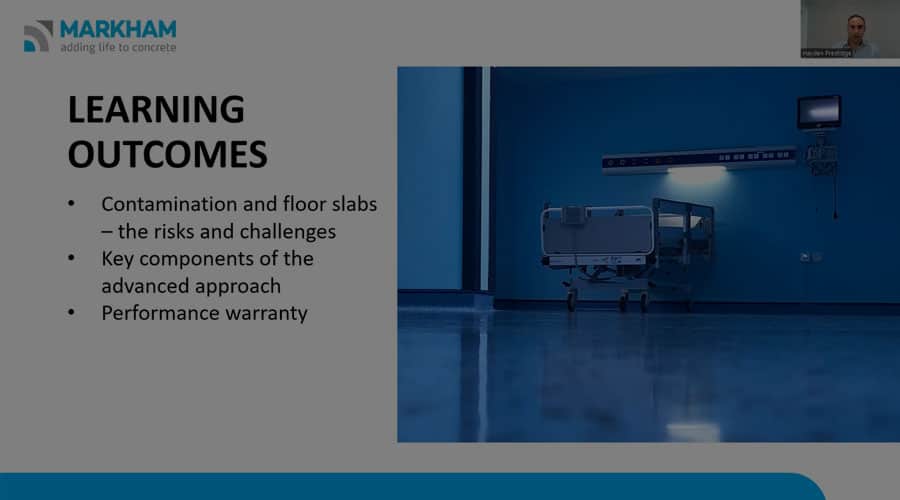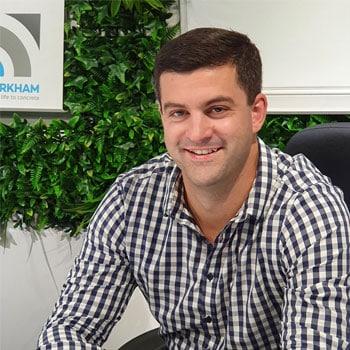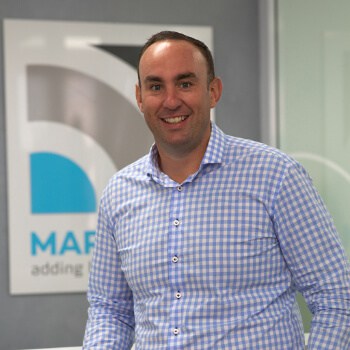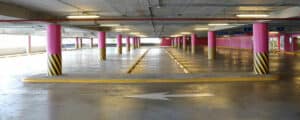Hygiene & Anti-Contamination in Concrete Floor Slabs

Hygiene & Anti-Contamination in Concrete Floor Slabs
Webinar Show Notes
MARKHAM Hygiene and Protection Treatments markhamglobal.com/markham-videos/concrete-hygiene-and-protection-treatments
FLOOR-TECT™ markhamglobal.com/markham-videos/floor-tect-floor-covering-protection
Hydrogel demonstration https://youtu.be/24hEgGK3Bq8
Learning Outcomes
- Contamination and concrete floor slabs – the risks and challenges
- Key components of our advanced approach
- The benefits of a performance-based warranty
HAYDEN: Hello and welcome. Thanks for joining. Just a couple more still joining, so we’ll just wait for a minute if everyone’s okay with that. So grab yourself a glass of water and we’ll be into it very shortly.
All right, good to see some good numbers there. So let’s kick-off. Thanks for joining, everybody. I’m Hayden Prestidge, based out of Sydney, and with me today is Brad Fulcher. But it’s all about hygiene and anti-contamination, stopping contamination in concrete. So why don’t we just kick it off?
Let’s jump into some quick housekeeping. Obviously, you signed up with myself and Wade Lanham. Now he has fallen ill. Sadly, there’s a lot of sickness going around. Thankfully Brad Fulcher has stepped in. So thanks, Brad. We will be going through this, and we’ll make it very interactive where possible. So anywhere you’ve got questions, just please use the Q&A in the chat box there, and we’ll do a session at the end where we will answer any questions live. Or raise your hand, things like that. But please feel free to chip in with comments, as that’s where you get the most benefit for us and you. So look forward to that.
Let’s kick off with a quick poll, just so we get a little bit of a feeling of our audience; where you’re from, what’s your background. So if you want to just tick one of those boxes for us quickly, that’d be much appreciated. Those joining, thanks for still joining. Just kicking off with a quick poll about what’s your background, just so we can tailor our conversation. We’ll leave that open for a little bit more. That’s good to see, we’ve got a whole lot involved with the design side. So that’s good. Welcome aboard everyone involved with design, obviously always good to see. There’s 25% or so interested in new technologies, so well done being an innovative mindset. It’s good to have you on board.
So I’m Hayden Prestidge, based in Sydney. I’ve been with MARKHAM for coming up eight years, and came out of the construction industry. So off the tools and into something very professional about protecting and getting the most out of concrete. With me today is Brad Fulcher.
BRAD: Yes. Good evening, everyone. Once again, thanks for joining. Brad Fulcher here, I’m based in the Sydney office. It’s good to see some good weather over here. Going to give you some sunshine, so that’s great. But yes, really keen to get into this webinar and have some good discussions with you guys.
HAYDEN: Thanks Brad. I’m missing that [recording] setup, I haven’t been into that office for a few weeks, nice little setup there. So that’s good. If we can click to the next slide, let’s have a quick look at our learning outcomes; what we want to discuss here, and what we’re going to get some input from you as the audience too. Now this is all about contamination and floor slabs, some of the risks and challenges they have. Now, why we’ve put this on is we’ve noticed a move in the aged care sector and the retirement sector. Obviously, a couple years back when the big COVID hit, a lot of this went on hold, and a lot of developments and things were put on ice. Now it’s very good to see this movement again, it’s a very needed part of our economy, all these buildings and structures. Everyone’s getting older, including all of us here today, and we need that care. So it’s all about protecting and what’s best for these sorts of structures in this medi-space, in this aged care space, hospital and healthcare space.
So we’ll be looking at what some of the key components are, as far as getting that best approach for your slabs in these types of builds. Then right through to what’s best for you, what’s going to give you that assurance, what’s going to give you that warranty or that guarantee performance and something that you can rely on. Something that you can hang your hat on and say, I’m happy with what we’ve achieved there. So let’s jump into what contamination is. Brad, you want to take us away?
BRAD: Awesome. Thanks for that, Hayden. Yes, let’s talk about contamination. Sorry, are people not picking up my audio?
Someone just said it’s fine now, that’s good. All right, let’s talk about contamination. Like I said, or you probably didn’t hear me, but I just started… To talk about contamination and hygiene, we really need to look at contamination in concrete in all aspects, and understand how contamination comes into concrete in the first place. This is whether we’re talking about a concrete slab or a hygiene situation, a bridge or a wharf or whatever it may be, contamination can get into concrete. This is because concrete is porous by nature. The reason being is that when concrete is being cured, or when it’s first poured, it’s obviously in a softer or plastic state, and moisture or water, or excess water – bleed water, as they call it – comes back out of the concrete, and leaves behind capillaries through the concrete. In this picture here, it’s shown as a blue path, and that’s going through the Calcium Silicate Hydrate in the sand that’s shown in the grey, and then you’ve got the aggregates around that.
The important thing to remember is that these capillaries that the moisture leaves become a permanent part of the concrete. This is in there for the life of the concrete. So these don’t close up over time, or they don’t get smaller, they don’t disappear; they’re there. We’ve got to remember that once this moisture has gone out, it can also get back into the concrete at any stage of the concrete’s life. So moisture is coming back in, it brings back contaminants, whatever these contaminants might be. That starts wearing or breaking down the concrete.
Why is this a problem? So now back to the hygienic situation. The reason this is a problem, say we’re in an aged care situation and contaminants have got into the floor, you get more moisture under there, then you start getting bacterial and fungal growth inside the concrete. You could imagine, deep down inside the concrete, it’s very dark, there’s moisture there, so it’s damp. It’s a perfect growing platform for these sorts of things to happen. One of ways we can tell this is happening is because of the odours in the room. No doubt people have been in these sorts of situations and you can smell it, and it’s not good. Also, this can’t be cleaned away easily. So we’re not talking about a surface clean, you know – just give it a good scrub and you’ve got rid of it. This is deep inside the concrete. We work on refurb projects where even a good grind doesn’t get rid of this bacteria that’s deep inside the concrete.
The other issue they do find is that the actual concrete itself starts to prematurely age, so it starts to break down the actual matrix of the concrete. You get your steel starting to rust out. It starts to crack open, and you start getting the concrete cancer. We also see that a fair bit in refurbs, where you pull up your floor coverings and then you’ve got concrete cancer underneath, and you have to deal with that before you go on with your refurb. So you’re talking a large sum of money to get this sorted. Back to you, Hayden.
HAYDEN: That’s good. As Brad said, no doubt we’ve all walked into an older age facility and noticed the odour, and predominantly that is coming from the concrete. Because urines and biofluids, things like that do get into the concrete very easily, through the carpet. Even you might have carpets that are like vinyl-backed etc., over time, they’ll break down with the wear on the concrete, and moisture does get through and into the concrete. So that’s the sort of thing which needs protected about. Thanks anyone that’s still joining, we’ve started and kicked off, but feel free to ask questions. There’s a Q&A function at the bottom there, and we’ll have a session at the end.
So let’s look at what sort of slabs are at risk. I’ve talked about aged care. Hospitals is a big one. Obviously, hygiene is of most importance, anything healthcare. Dental clinics, doctors, facilities, things like this. Laboratories is another big one. Universities, schools, things like that. Then right through to animal housing, kennels, those sorts of facilities. Then public spaces, even stadiums and things. We’ve done a lot of prison work, and protecting against contaminants getting into the concrete. So these sort of examples.
So there’s a lot of scope and a lot of need, really, for protecting concrete. So no doubt you’ll all have projects in minds. A big portion of you are designers today, so some of these might ring bells as we go through. Please feel free to raise your hand and ask a question about them.
So what’s the long-term cost? First, let’s look at the cost of doing nothing. Obviously, straight up, you’re saving money on your structure, building it. But over time, that degradation of concrete is huge; that cost of maintenance is huge. The cost of hygiene, the cost to keep clean, is huge. Then for the tenants themselves, who’s using the facility? What do they get and how do they react to what their concrete is giving them, if you know what I mean? Often, in a high-care dependency unit and an aged care facility, they’ll almost renovate a room every time they get a new tenant, and that often involves pulling up the flooring. If it hasn’t been treated, grinding back, getting back to something nice and clean and starting again. These sorts of things are huge dollars and time over the life of a structure, if it’s not done right at the start. So this is the sort of things we need to start thinking about, getting it into design, getting it into the project, and creating what’s actually needed for this job.
If we just jump to the next slide, let’s have a deep dive right inside concrete. I don’t know how many of you have concrete technologists on here or know much about concrete. Well, neither do I really. But I know a little bit, and I just want to share a little bit about this. So this is looking right inside the concrete through a microscope now. As you can see, there’s the large big plates, they look like sort of rice cracker wafers there. They’re calcium hydroxide plates, and they’re formed through the cement and the reaction process. They’re all through the concrete, and that’s sort of the strength of the concrete. But as you can see around them, there’s a lot of area, there’s a lot of holes around them, and there’s a lot of porous activity around that. That’s the area that moisture and contaminants get into. As you can see at the bottom of the picture is quite dense, very dense, and that’s Calcium Silicate Hydrate forming there. So that’s the grey matter, the real binder in concrete. That’s very dense and that’s good. But up above there is what needs blocking and needs densifying.
So we do that through treatment, which we bring in a colloidal silica treatment into the concrete and the formation of a hydrogel. I don’t know if anyone on this call has seen us do it before, but we actually create the gel in the little jar, some of you probably might have seen that already. But that gel is forming in all these little pores. Now, we have to remember, this is at microscopic level. So even a hair out of not the front of my head, but the back of my head, would look similar in size to this, if you know what I mean.
So we do this through a spray-applied treatment or admixture. Spray-applied is best for this aged care sector that we’re talking about, because it does your curing as well; we’ll run through some of these things soon. But hydrogel doesn’t introduce anything foreign to the concrete, it’s just creating more of the good stuff, more of that Calcium Silicate Hydrate, and really densifying all that area. Then, it prevents moisture moving up or down or in, it prevents moisture moving through the concrete, and obviously, it prevents contaminants growing and moving into the concrete. So things like Brad was talking about; fungal growth, etc; that needs moisture to grow. If you stop it and take away moisture migration, you’re effectively stopping and increasing hygiene in those sectors.
Now another quick note is environmentally safe. This project, no doubt, we’re all building Green Star nowadays, and Green Building Council Australia and New Zealand, we’re looking for solutions. We can say we have ticked those boxes and recognized now by Green Building Council for these treatments. So it’s good.
Now, this is jumping back to that slide which we looked at earlier. So we were looking right inside the concrete, now we’re coming back. So we apply this as a cure. So you pour your slabs, and then your ride-on trowels, or your floats – you work on the slab. Then when that’s finished, the concrete placers are finished, MARKHAM come on and provide this treatment and spread it across the top. As Brad said, it comes back through this road system and fills up those porosities and those pores in the concrete.
Now what that’s doing is retaining that moisture in there to keep curing, so it gives you a good quality slab. But then, more importantly is the moisture control and the anti-contamination elements of it. It’s going to give you the long-term protection and 15-year warranty standard. That’s been a long-standing … some of the aged care providers like. Opal, Ryman, these guys have used it for years; Summerset, Metlife, Japara. We’ve got a lot of track record with aged care facilities. Hopefully that makes sense. If it didn’t, something through that, if you want a little bit more opened up, just pop it in the Q&A. But let’s jump now to the next part Brad.
BRAD: That’s good. So these systems all come under our FLOOR-TECT system. So this is a moisture-control system that’s for under any resilient flooring system, whether that’s an aged care or any type of flooring you’re talking about. Couple of the main points: It complies with ASTM E96. I’m not sure if everyone on this call is aware, this is recently being updated. Just to make sure that you are aware that we do apply to this, the newest version of this. If you have any questions on this or want further information, pop it in the Q&A and we can talk more about that later. It complies with AS1884. Then as Hayden was saying, curing and moisture control in the one system.
Now, why we are emphasizing that one system is this is a huge time-saver for a builder. At curing stage, obviously, your concrete needs curing, so you’re doing something anyway. So having a system that can apply at that same time, the one system which does your curing and moisture [control] is a huge time saver. Builders love it! It’s available in the standard systems and also in the hygiene-enhanced. Obviously, at the moment, we’re concentrating more on the hygiene systems for your aged cares. But it’s all there under that one FLOOR-TECT system. You can look it up online, there’s plenty more information on there about that.
We need to talk about our end-to-end service. This is pretty much what MARKHAM is underpinned on. Every system we do, we offer this. So we work with the design and specification. So we actually have a team, their focus is on this sort of work. So working with the designers, engineers, architects, and looking at builds and working out where we can help them or if we can help them, and coming up with a specific solution for your build. Then we work on estimating. So we work closely with builders all around the country, working with the estimating team, coming up with the best way we can quote them, or the way we can do job. Looking at, obviously for the builders, any cost savings we can offer them as well.
Then the big part, as Hayden said earlier, we do the application of this product as well. So we supply and apply it, we have guys onsite. So we’ve got a full team around Australia and New Zealand that are perfectly capable of coming out and doing this work for you.
This is all underpinned by our quality control. So everything we do is documented, which allows us to give our warranties. So we don’t just give a product warranty, we give a full performance-based warranty. For your full peace of mind, or for your client’s peace of mind, our standard warranties are 15 years. So we’re not warranting the product, we’re warranting the end result. Whether it’s moisture control under your floor coverings, we’re warranting that no moisture can come up through your slab.
With that, that does end our Wednesday webinar for today. Keen for any more questions you can pop through in there, we’ll spend a little bit time answering them now. You can also email your questions if they’re a little bit more project-specific or you want a bit more detail on them, or actual physical information, and we’ll deal with them. Emails are up there; we’ll leave them up for a little bit longer.
HAYDEN: A question for you, Brad, to kick off. I don’t think we discussed it, but what age slab can this be added to? Does it have to go on as a cure?
BRAD: Great point, great question. We should have covered that. Obviously, the best time to do is at cure stage. But then when we’re talking about older buildings, we did say we do refurbs. The reason we go on at this stage is, obviously if it hasn’t been done at that cure stage, there’s no issues going on at any time. If it has been missed at cure stage, we can go down just before the floor layers go down, or any other stage when they’re doing that refurb and ripping it up and need to deal with it then. Anything to add on that one?
HAYDEN: Tell me about the compatibility. That’s always a question, someone should’ve probably asked it already. But floor covering always goes over the top of these things, how does that work?
BRAD: Yes, this is a penetrating system. As we showed in those early images, we’re going back down through those capillaries. So it’s not a surface solution, and it’s all doing its work inside the concrete, and it doesn’t introduce anything foreign into the concrete. So no compatibility issues, anything that’s designed to be used on bare concrete can be used on a FLOOR-TECT treated slab as well.
HAYDEN: Cheers! A couple of questions here. How long is the warranty? MARKHAM is very project-specific, but standard warranty on our MEDI+ seal system is 15 years performance. That means 15 years of protection of moisture movement and contaminant ingress into the concrete. So hopefully that answers that one.
Tell us more about the AS1884 compliance. Yes, good. So last year, the standards board went through the flooring standard for resilient flooring – so that’s all your vinyl flooring, things like that – and really made it easier to get right overall, as far as what’s needed. I think it’s just Australia at the moment, but no doubt New Zealand will follow. So they added a test in there to be compliant to E96, which is an American test, and that’s testing moisture vapour, over a period of time, that’s coming out the concrete. So to get a system to comply has been difficult, but we’ve got that certificate now, and we can apply to that AS1884. Hopefully, that makes sense.
BRAD: Another question has come through. How long after spraying can we lay floor finishes? So if we’re doing a retrofit at 70–72 hours, we do have to give the concrete time to take in the system, and make sure any reactions are finished before we start laying floors. Typically, in these situations, we sort of do the work on the Fridays, or towards the end of the week, leave it over the weekend, and then the floor layers can kick off on Monday. So it works pretty well in that way. Then on new concrete, so if it goes down at curing stage, 25 days after that, you can lay out your floors, so it can actually speed up time in programs as well. It’s often used in schools and those sorts of situations where they’ve got a tight timeline, and they’re trying to lay their floor coverings a bit quicker than you normally would.
HAYDEN: Question around alkalinity levels, does it affect alkalinity levels? Now, the product itself in a pail is high pH. But because it’s applied as a light coat to the concrete, it does not affect the finished levels of the concrete itself, so to speak. There’s not enough product per square metre or per coverage to affect the concrete surface. No, it doesn’t, and even over time, it won’t affect the alkalinity level that the concrete gave itself, if that makes sense. Hopefully answers that.
Does the spraying or additive provide a better finish? Finish as in concrete finish? – if anyone wants to expand on that question, or the performance? So there’s two different things here. The spray treatment goes on, and it’s probably more effective for what we’re talking about, as far as moisture control and hygiene contamination. But when you’re starting to look at basement or waterproofing or protecting marine structures or wastewater or things like this, that’s when additive comes in, and then it’s right through your whole concrete matrix. As far as the finish of the concrete, you wouldn’t know it’s in there as such. It’s not a product that can be seen from the surface, and you’ll get just as good a finish; it closes off, finishes really well, pumps, places as well. If that didn’t answer that question or it didn’t make sense, just pop another note in there. Or anyone else that may have a follow-up question to those ones.
Thanks, that was a good round of questions. Also, we’ll send out an email straight after this for the quick survey. Give us some feedback, tell us how it went. If you have got any follow-up questions, we’re more than happy to take a call on that as well. So thanks again for joining, taking part of your day and to learn. Good to see you all on board.
Oh, there’s another one. Brad, you want to take that? Would you use this in public areas in aged care footpaths?
BRAD: There’s no reason why not to, we do do footpaths and those sorts of things. Typically it doesn’t always come into the scope, and we do use another product, one of our products which is a more standard curing and sealing product, rather than a full hygiene protection. But just on that note, things like vets or dog kennels, those sorts of things, we do do obviously any concrete they do have, because of the nature of the beast, you might say. But typically around an aged care, we would just use a standard sealing product. But it can be used, no doubt about that at all.
HAYDEN: We actually do a lot into like, not so much footpaths, but prison training facilities and things like that; and stadiums, where you’ve got food and drink all over stadiums. So that sort of protection is required. Where it’s just foot traffic itself, it’s probably an overkill for the product as such.
BRAD: The level of risks that you’re looking to, you make a decision off of that.
HAYDEN: That’s good. We’ll wait for a minute longer, just see if anything else pops on. Otherwise, everyone enjoy your day, feel free to log off if you’re done. But thanks very much for joining. That’s good, informal CPD certificates? Now we can provide a certificate that you have joined this. We do have a CPD presentation as well, which if you want to get in touch with us, we can do a formal CPD presentation and earn those credits here as well. So ideally, you and the team, and we can take the time to do that. That’s good.
BRAD: Another question come in about bathroom set downs. So bathroom set downs would also be another area as a screed is usually laid over; would you suggest leaving these spaces and spraying after? Typically we spray it at the cure stage, so we spray the concrete in the set down, and we spray the whole slab in that one spray. The reason being is when they put the screed on, they also do waterproofing around that before they tile or whatever they’re doing in their bathroom. So if you like, it’s got two levels of protection: underneath your screed, your slab has been protected by the FLOOR-TECT system, and then the screed being protected by the bathroom waterproofing system.
HAYDEN: You can do the screed. A lot of screed has polymers in them that have an element of protection in themselves, so they’re almost carrying their own moisture protection to a point, not guaranteed. But the main thing is the stuff getting into the slab, that’s where the degradation works, if you know what I mean. But we have definitely done screeds. We also do a lot in the UK, and they build everything with screed, so a lot of that. They pour their floors terrible, and then lay the water heating systems throughout, they always use screed. So we do a lot of that, and it’s similar to bathrooms. The main thing is to come through and treat your whole slab, especially as a cure, through set-downs and everything at that point, and then the apartments are freed up for the builders and finishers.
That’s good, good questions. Thanks all. All right, that’s probably us over and out. Thanks for joining, keep posted for the next one. Thanks for coming on board, thanks all!
More about MARKHAM
MARKHAM are dedicated to providing innovations for concrete and construction. Focusing on concrete waterproofing solutions, penetrating concrete sealers and durability treatments concrete.
Newsletter
Sign up for email updates on the latest collections, campaigns and videos.




